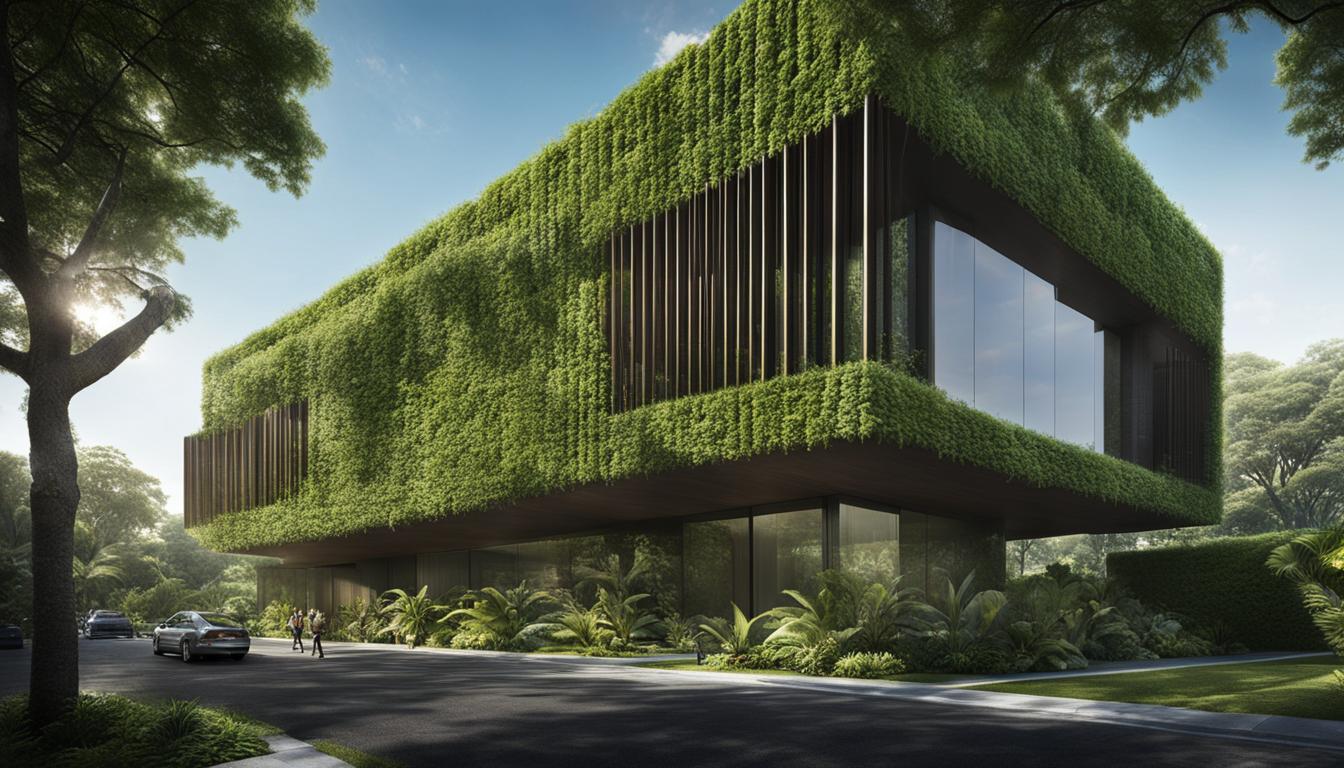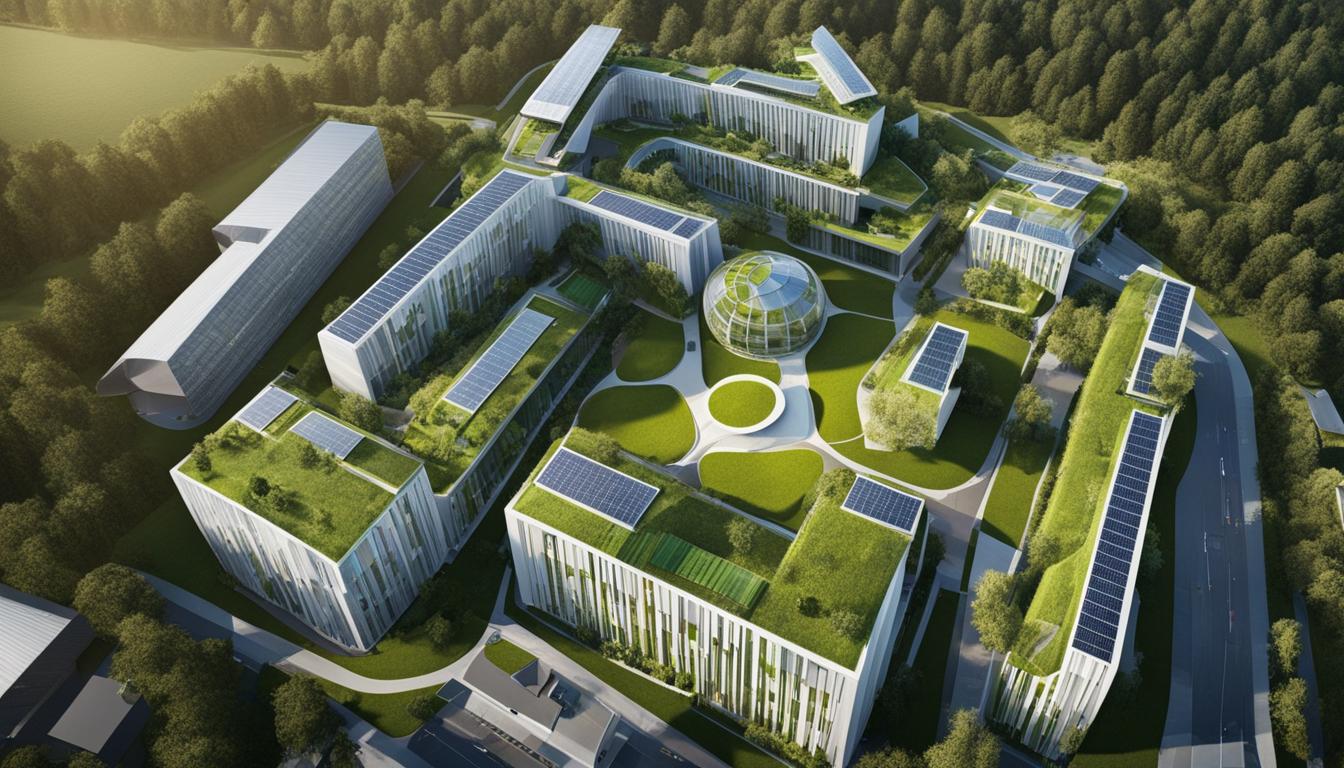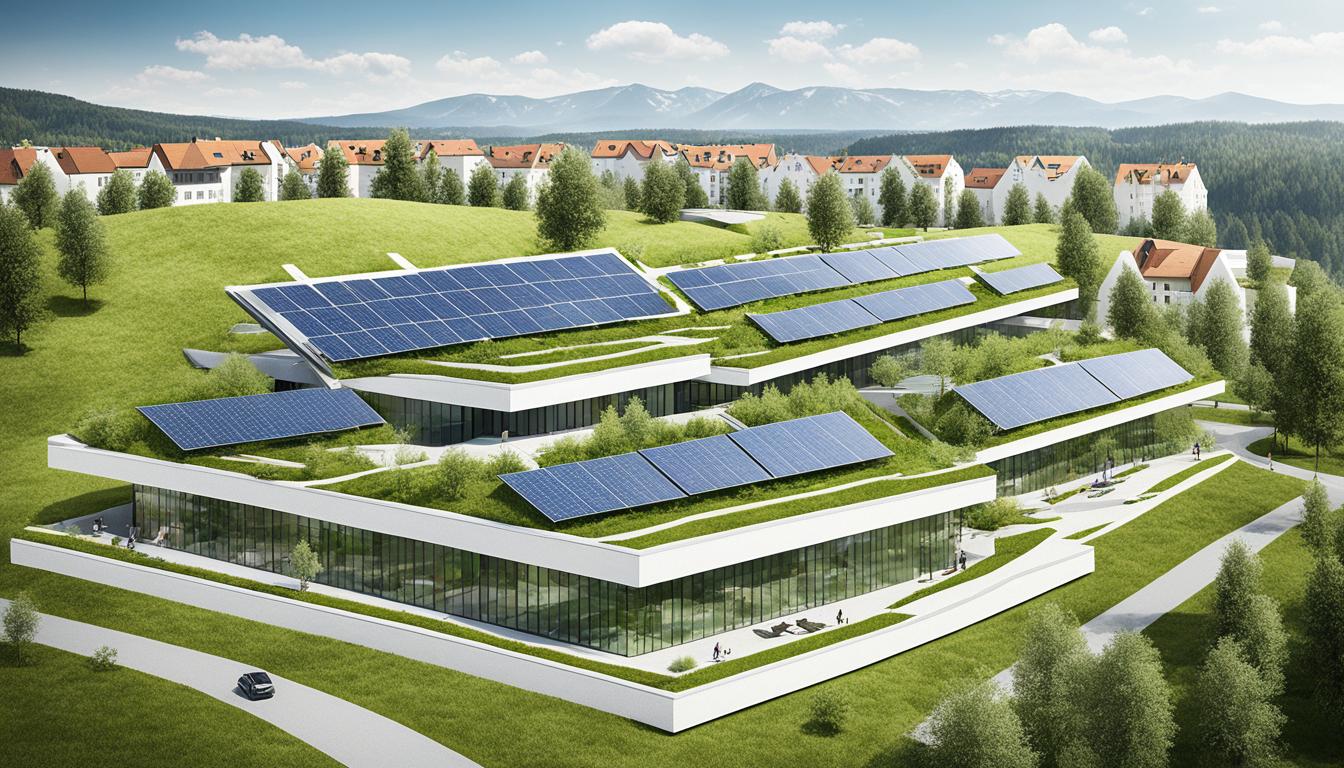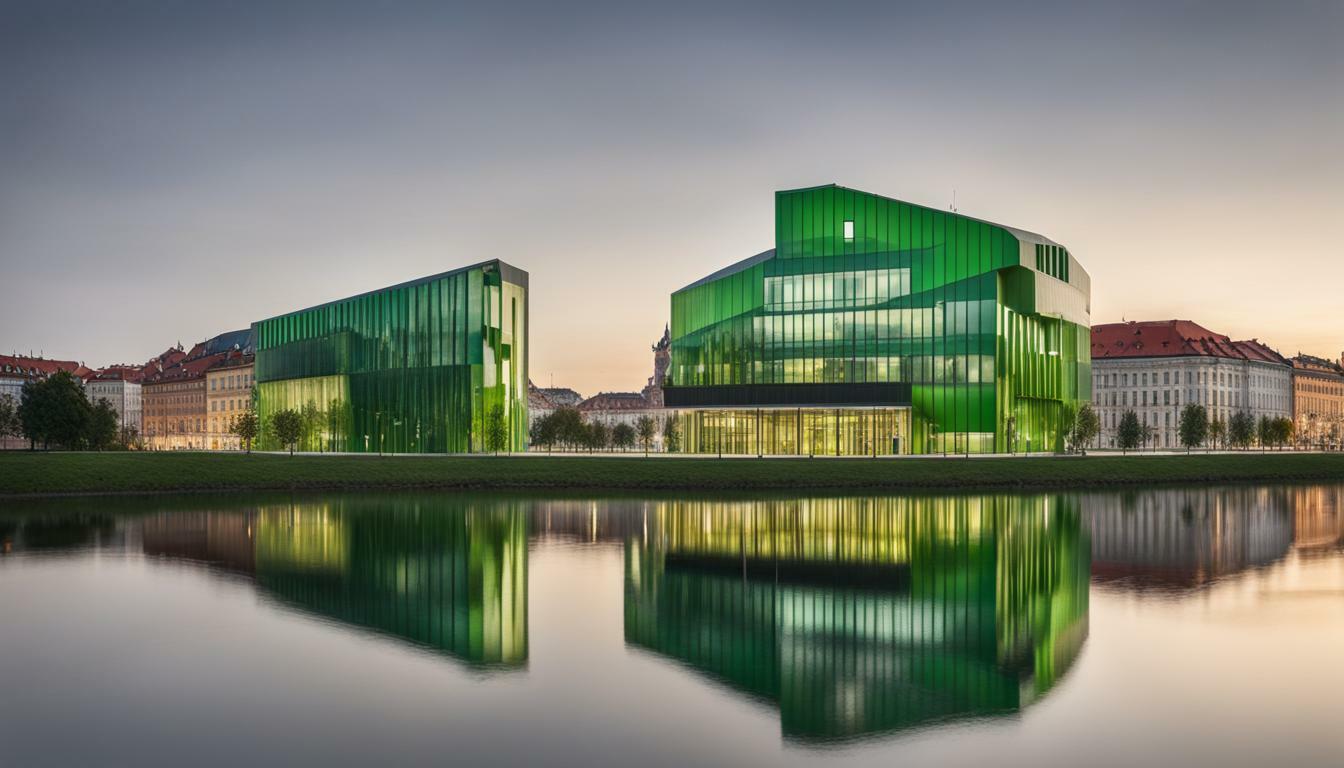Mauritius Top Green Buildings
The building sector is vital for a country’s economy and provides employment and housing. However, the need for sustainable development in this sector is crucial due to climate change and resource scarcity. Green buildings aim to be environmentally responsible and resource-efficient throughout their lifespan. Design guidelines for green buildings include considering the site potential, reducing energy consumption, conserving water, using sustainable building materials, and improving indoor environment quality.
Key Takeaways
- Mauritius is embracing sustainable architecture with its top green buildings
- Green buildings prioritize energy efficiency and resource conservation
- Design guidelines consider factors like site potential, water conservation, and indoor environment quality
- Mauritius is taking steps towards an environmentally friendly construction industry
- Green buildings contribute to a more sustainable future for Mauritius
Importance of Sustainable Building Practices
Sustainable development in Mauritius is becoming increasingly crucial as the country strives to address climate change and promote environmental responsibility. One key aspect of sustainable development is the implementation of green building practices. These practices aim to reduce the negative impact of construction on the environment by using sustainable building materials and incorporating renewable energy sources in the construction process. By adopting sustainable building practices, Mauritius can contribute to global efforts in reducing carbon emissions and conserving resources.
Green building materials play a significant role in sustainable construction. These materials are eco-friendly and have a lower environmental impact compared to traditional building materials. They include materials such as recycled wood, bamboo, and natural insulation materials. Using these materials not only reduces the carbon footprint of the building but also promotes resource conservation and reduces waste. Additionally, renewable energy sources like solar power can be integrated into the construction process, further reducing the building’s reliance on fossil fuels and reducing its environmental impact.
It is important to note that sustainable building practices extend beyond the construction phase. The operation and maintenance of buildings also play a critical role in promoting sustainability. Energy-efficient practices, such as using energy-saving appliances and implementing smart building management systems, can significantly reduce energy consumption and lower greenhouse gas emissions. Proper waste management and water conservation are also essential aspects of sustainable building practices in Mauritius.
By embracing sustainable building practices, Mauritius can not only create a more environmentally friendly built environment but also reap economic benefits. Green buildings often have lower operating costs due to reduced energy consumption, leading to long-term cost savings. Additionally, sustainable buildings provide healthier indoor environments, promoting the well-being and productivity of their occupants. As the demand for sustainable construction grows, it is crucial for Mauritius to continue supporting and promoting green building practices to ensure a sustainable and resilient future.
Designing Sustainable Buildings
Designing a sustainable building is a multidisciplinary process that involves integrating various elements to minimize environmental impact and optimize resource usage. Green building design considers six fundamental principles: site potential, energy consumption, water conservation, building materials, indoor environment quality, and the implication of building operations and management. By carefully considering these aspects, architects and designers can create eco-friendly structures that contribute to a more sustainable future.
One key aspect of green building design is the intelligent integration of the building into its surrounding environment. This includes factors such as orientation, landscaping, and the use of natural elements for energy reduction, such as natural ventilation and passive heating and cooling systems. By leveraging the natural resources available at the site, buildings can minimize their reliance on external energy sources and reduce their carbon footprint.
Another crucial consideration is the choice of building materials. Green buildings prioritize the use of sustainable materials that have a minimal environmental impact. This includes materials with high durability, low embodied energy, and the potential for reuse or recycling. For example, using recycled or salvaged materials, responsibly sourced timber, and low VOC (volatile organic compound) products can significantly reduce the environmental footprint of a building.
Eco-Friendly Construction Methods
In addition to sustainable design principles, eco-friendly construction methods play a vital role in creating green buildings. These methods focus on minimizing waste, conserving resources, and reducing pollution throughout the construction process. Some examples of eco-friendly construction methods include:
- Pre-fabrication: Off-site fabrication of building components reduces waste and energy consumption during construction.
- Recycled materials: Incorporating recycled materials, such as crushed concrete or reclaimed wood, reduces the demand for virgin resources.
- Water conservation: Implementing water-efficient construction practices, such as rainwater harvesting systems or low-flow plumbing fixtures, helps conserve water resources.
- Renewable energy integration: Designing buildings to incorporate renewable energy sources, such as solar panels or wind turbines, reduces reliance on fossil fuels.
By incorporating these eco-friendly construction methods alongside sustainable design principles, architects and builders can create buildings that are not only environmentally responsible but also economically viable in the long run.
| Design Principle | Description |
|---|---|
| Site Potential | Optimizing the building’s location, orientation, and landscaping to maximize natural resources and minimize environmental impact. |
| Energy Consumption | Reducing energy consumption through efficient HVAC systems, insulation, and the use of renewable energy sources. |
| Water Conservation | Implementing water-efficient fixtures, rainwater harvesting systems, and landscaping techniques to minimize water usage. |
| Building Materials | Choosing sustainable materials with low embodied energy, high durability, and the potential for reuse or recycling. |
| Indoor Environment Quality | Enhancing occupant comfort and well-being through proper ventilation, natural lighting, and low VOC materials. |
| Operations and Management | Implementing strategies for efficient building operations, maintenance, and occupant behavior to minimize environmental impact. |
Types of Green Houses
When it comes to green houses, there are various eco-friendly materials that can be used to construct them. These materials prioritize sustainability, energy efficiency, and a reduced environmental impact. Let’s explore some of the different types of green houses:
Bamboo Houses
Bamboo is a versatile and sustainable material that can be used in construction. It is resilient, fast-growing, and has a low carbon footprint. Bamboo houses are not only eco-friendly but also aesthetically pleasing, with unique designs that showcase the natural beauty of this material.
Cellulose Insulation
Cellulose insulation is made from recycled paper and other plant-based materials, making it an excellent choice for green houses. It provides effective insulation, reducing energy consumption and improving overall energy efficiency. Cellulose insulation is also non-toxic and helps to reduce waste by repurposing recycled materials.
Cob Houses
Cob houses are made by mixing clay, sand, straw, and water. This mixture is then used to build solid walls, offering excellent thermal insulation. Cob houses are not only sustainable but also durable and can withstand different climate conditions.
To summarize, green houses can be constructed using a variety of eco-friendly materials, each offering unique advantages in terms of sustainability and energy efficiency. From bamboo houses to cob houses and cellulose insulation, these green building options contribute to a greener and more sustainable future.
Green Building Initiatives in Mauritius
The efforts to promote sustainable development in Mauritius have led to a growing emphasis on green building practices. While the private industry has taken the lead in implementing eco-friendly construction projects, the government is also collaborating with architects and engineers to support sustainable initiatives in the building sector. One standout example of sustainable architecture in Mauritius is the eco-building of the Mauritius Commercial Bank (MCB) located in Quatre-Bornes.
The MCB eco-building is a pioneering project that showcases the country’s commitment to sustainable development. It holds the distinction of being the first building in the southern hemisphere to receive a Building Research Establishment Environmental Assessment Method (BREEAM) rating. This recognition highlights the eco-building’s ability to meet stringent sustainability criteria and create a greener future.
The MCB eco-building incorporates various sustainable design elements. For instance, the building’s orientation maximizes natural daylight, reducing the need for artificial lighting and minimizing energy consumption. Shading devices help minimize heat gain, further optimizing energy efficiency. Additionally, the use of renewable energy sources, such as solar panels, contributes to the building’s reduced environmental impact. Rainwater harvesting and reuse systems are also implemented to conserve water resources.
| Key Features of the MCB Eco-Building | BREEAM Rating |
|---|---|
| Optimized orientation for natural daylighting | Excellent |
| Shading devices to reduce heat gain | Excellent |
| Renewable energy sources (solar panels) | Very Good |
| Rainwater harvesting and reuse systems | Good |
The MCB eco-building serves as an inspiring example of sustainable construction in Mauritius. It demonstrates the potential for green buildings to adapt and drive positive change in the face of environmental challenges. These initiatives pave the way for a greener, more sustainable future for the island nation.
Benefits of Green Buildings
Green buildings offer numerous benefits that contribute to a more sustainable and energy-efficient future in Mauritius. One of the primary advantages of green buildings is their reduced energy consumption. By incorporating energy-efficient design features and technologies, green buildings minimize the use of fossil fuels and decrease carbon emissions. This not only helps combat climate change but also reduces the country’s reliance on costly and finite fossil resources.
Another significant benefit of sustainable building practices is the reduction of costs over the long term. While the upfront costs of constructing green buildings may be slightly higher, the investment pays off through lower energy bills and maintenance expenses. Additionally, green buildings often have longer lifespans and higher market values, providing a financial advantage to homeowners and investors. These cost savings make green buildings an attractive option for both individuals and businesses in Mauritius.
Furthermore, green buildings contribute to public health benefits. By prioritizing indoor air quality and using non-toxic building materials, green buildings provide healthier living and working environments. Improved air quality, access to natural light, and efficient ventilation systems can enhance occupant well-being and productivity. The use of sustainable building practices also reduces the environmental impact of the construction industry, leading to cleaner air and a better quality of life for the entire community.

Key Benefits of Green Buildings:
- Reduced energy consumption and carbon emissions
- Long-term cost savings
- Increased market value of properties
- Improved indoor air quality and occupant health
- Enhanced productivity and well-being
“Green buildings not only contribute to a more sustainable future but also provide financial savings and improved well-being for occupants.”
Table: Comparative Analysis of Green Buildings vs. Conventional Buildings
| Aspect | Green Buildings | Conventional Buildings |
|---|---|---|
| Energy Consumption | Significantly lower energy consumption due to energy-efficient design and technologies | Higher energy consumption, leading to increased utility bills |
| Costs | Long-term cost savings through reduced energy bills and lower maintenance expenses | Higher operational costs and maintenance expenses |
| Environmental Impact | Reduced carbon emissions and resource depletion | Higher carbon footprint and greater resource consumption |
| Indoor Air Quality | Enhanced indoor air quality through the use of non-toxic materials and efficient ventilation systems | Poor indoor air quality due to the presence of toxins and inadequate ventilation |
Overall, green buildings play a crucial role in creating a sustainable and resilient built environment in Mauritius. Their energy-efficient design, cost savings, and positive impact on public health make them a valuable investment for individuals, businesses, and the environment.
Green Buildings and Climate Change

Buildings are a significant contributor to global warming, being responsible for over 40% of global carbon dioxide emissions. This highlights the urgent need for energy-efficient and green buildings to tackle global climate change. By adopting sustainable practices in construction and operation, buildings can play a crucial role in reducing carbon emissions and mitigating the effects of climate change.
Energy-efficient and green buildings prioritize the use of renewable energy sources, optimize energy consumption, and minimize greenhouse gas emissions. They incorporate design features such as solar panels, efficient insulation, and advanced heating and cooling systems to reduce energy demand. Additionally, green buildings promote sustainable materials, water conservation, and waste reduction, further contributing to environmental sustainability.
The role of buildings in global warming goes beyond direct emissions. They also impact the environment through their construction, maintenance, and eventual demolition. Sustainable building practices aim to minimize the carbon footprint associated with the entire lifecycle of a building, including material extraction, transportation, and waste management. By considering the environmental impact throughout a building’s lifespan, we can make significant strides in addressing climate change.
Cost Considerations in Green Building
When deciding to invest in green buildings, one of the key factors that developers and investors consider is the cost. While the upfront expenditure for green buildings may be higher compared to traditional construction, it is important to look at the long-term cost savings and benefits that green buildings offer.
A life-cycle cost analysis is a useful tool for evaluating the overall financial impact of green buildings. This analysis takes into account not only the initial construction costs but also the operating and maintenance costs over the building’s lifespan. Green buildings are designed to be energy-efficient, which results in lower energy consumption and reduced utility bills over time. Additionally, the use of sustainable materials and technologies contributes to lower maintenance and replacement costs.
Although there may be higher upfront expenditures in the construction phase, green buildings can provide significant long-term cost savings. The integration of energy-efficient systems, such as solar panels and efficient HVAC systems, can help reduce energy costs. Moreover, green buildings often have better indoor air quality, leading to improved occupant health and productivity, which can have financial benefits for businesses.
| Cost Considerations | Traditional Construction | Green Building |
|---|---|---|
| Construction Costs | £X | £X+ |
| Operating and Maintenance Costs | £X | £X- |
| Energy Costs | £X | £X- |
| Health and Productivity Benefits | Not considered | Improved |
Therefore, while green buildings may require higher upfront investments, the long-term benefits, including reduced energy consumption, lower operating costs, and improved occupant health, outweigh the initial expenses. Green buildings offer a sustainable and financially viable solution that aligns with the global efforts to address climate change and promote a greener future.

Green Building Example – The Mauritius Commercial Bank
The Mauritius Commercial Bank’s eco-building in Ebene is a groundbreaking example of sustainable architecture in Mauritius. It was the first building in the southern hemisphere to receive a BREEAM certificate, recognizing its sustainable design and energy-saving features. The building’s orientation, insulation, triple-glazed windows, natural daylighting, and solar power generation contribute to its energy efficiency and reduced environmental impact.

The Mauritius Commercial Bank’s eco-building stands as a testament to the growing commitment towards sustainable development in the country. With its innovative design and energy-saving features, it sets a benchmark for future green building projects in Mauritius. The BREEAM certification highlights the bank’s dedication to environmental responsibility and showcases its leadership in sustainable construction.
The design features of the Mauritius Commercial Bank’s eco-building include:
- Optimal building orientation to make the best use of natural light and reduce reliance on electric lighting.
- High-quality insulation to minimize heat transfer and maintain comfortable indoor temperatures.
- Triple-glazed windows to enhance thermal performance and minimize heat loss.
- Natural daylighting strategies to reduce energy consumption and create a pleasant indoor environment.
- Solar power generation through the installation of photovoltaic panels, promoting the use of renewable energy sources.
The combination of these design features enables the Mauritius Commercial Bank’s eco-building to achieve significant energy savings and reduce its carbon footprint. It serves as a shining example of how sustainable architecture can contribute to a greener and more environmentally conscious future.
| Energy-Saving Design Features | Benefits |
|---|---|
| Optimal building orientation | Maximizes natural light, reduces reliance on electric lighting |
| High-quality insulation | Minimizes heat transfer, maintains comfortable indoor temperatures |
| Triple-glazed windows | Enhances thermal performance, minimizes heat loss |
| Natural daylighting strategies | Reduces energy consumption, creates a pleasant indoor environment |
| Solar power generation | Promotes the use of renewable energy sources |
Islands and Global Sustainability
Islands, with their unique characteristics and natural environments, have the potential to make significant contributions to global sustainability. Despite having a relatively low carbon footprint and minimal impact on climate change, islands can serve as beacons of sustainable architecture and inspire sustainable practices worldwide.
One notable example is the Mauritius Commercial Bank’s eco-building in Ebene, which showcases the possibilities of sustainable design and construction even on small islands. This groundbreaking project, the first building in the southern hemisphere to receive a BREEAM certification, incorporates energy-saving features and sustainable design elements. From its orientation and insulation to triple-glazed windows and solar power generation, the eco-building demonstrates the effectiveness of sustainable architecture in reducing environmental impact.
By embracing sustainable building practices, islands can lead the way in addressing climate change and promoting environmental responsibility. Through the use of renewable energy sources, efficient resource management, and eco-friendly materials, sustainable architecture in islands can contribute to the preservation of natural resources and the reduction of carbon emissions. These efforts not only benefit the local communities but also have a global impact in the fight against climate change.
As islands continue to prioritize sustainability in their building practices, they set an example for other regions and provide valuable insights into creating a more sustainable future. By focusing on low carbon footprints and incorporating sustainable architecture, islands can inspire communities worldwide to adopt environmentally responsible practices and contribute to a more sustainable planet.

Conclusion
Sustainable building practices and environmental responsibility are vital for the future of green buildings. These practices aim to address climate change, reduce resource waste, and create a more sustainable and environmentally responsible future. By optimizing natural resources, reducing energy consumption, and using eco-friendly materials, we can not only save costs but also improve public health and contribute to a healthier planet.
Green buildings play a significant role in promoting sustainable development. They are designed to be environmentally responsible, resource-efficient, and prioritize the well-being of occupants. With the increasing pressure to address environmental issues in the building sector, the construction industry is embracing green building practices and making efforts towards a more sustainable future.
As we move forward, it is crucial to continue advocating for sustainable building practices. By incorporating design principles that focus on site potential, energy consumption, water conservation, building materials, indoor environment quality, and the implication of operations people, we can create buildings that have a positive impact on the environment and the well-being of individuals.
The future of green buildings lies in our commitment to sustainable development, environmental responsibility, and the integration of green building practices. By embracing these principles and working together, we can shape a future where our buildings harmoniously coexist with the environment, conserve resources, and contribute to a sustainable and greener world.
FAQ
What are green buildings?
Green buildings are environmentally responsible and resource-efficient structures that aim to reduce energy consumption, conserve water, and improve indoor environment quality throughout their lifespan.
Why are green buildings important?
Green buildings play a crucial role in sustainable development by reducing carbon emissions, waste of resources, deforestation, and visual pollution. They promote the efficient use of natural resources and incorporate renewable energy sources.
What are the principles of green building design?
The principles of green building design include considering site potential, reducing energy consumption, conserving water, using sustainable building materials, improving indoor environment quality, and involving operations people.
What materials can be used for green houses?
Green houses can be built using eco-friendly materials such as bamboo, cellulose insulation, cob, composite wood, cordwood, cork, hemp, insulating concrete forms, lime render, adobe, and straw and earth.
What are some green building initiatives in Mauritius?
In Mauritius, green building initiatives are mainly led by the private industry. An example is the eco-building of the Mauritius Commercial Bank located in Quatre-Bornes, which is the first building in the southern hemisphere to receive a BREEAM rating for sustainability.
What are the benefits of green buildings?
Green buildings offer benefits such as reduced energy consumption, cost savings, improved occupant productivity, increased market value, and better indoor air quality. They contribute to a better quality of life and promote sustainable development.
Why are green buildings important for addressing climate change?
Buildings are responsible for a significant portion of global carbon dioxide emissions. Constructing energy-efficient and green buildings is crucial for mitigating climate change and reducing carbon emissions.
How much does a green building cost?
The cost of a green building depends on the project’s goals, level of sustainability, and the experience of the design and construction team. While upfront costs may be higher, the long-term cost savings from reduced energy consumption outweigh the initial investment.
Can you provide an example of a green building in Mauritius?
The Mauritius Commercial Bank’s eco-building in Ebene is a prime example of sustainable architecture in Mauritius. It has received a BREEAM certificate for its sustainable design and features such as orientation, insulation, natural daylighting, and solar power generation.
How can islands contribute to global sustainability through green buildings?
Islands, despite their low carbon footprints, can make significant contributions to global sustainability. The Mauritius Commercial Bank’s eco-building showcases how sustainable architecture can tackle climate change and inspire sustainability efforts globally.
Why are green buildings important for the future?
Green buildings and sustainable architecture are essential for addressing climate change, reducing resource waste, and promoting a sustainable future. Adopting sustainable building practices can lead to cost savings, improved public health, and a healthier planet.








